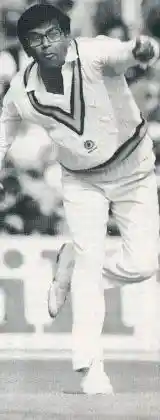It is never too late
While the Caribbean was the land of outlandishly quick fast bowlers and Australia produced formidable batters of steel, India was the home of spin. Names like Bedi, Prasanna and Venkat had it in them to give the best players a run for their money. Among these iconic names was a man who came onto the international scene a little later, but left a mark almost just as deep.

Dilip Doshi and his memorable bowling action. Image credits: ESPNCricinfo
Gujarat-born former cricketer Dilip Doshi was a slow left-arm orthodox bowler who represented India in 33 Tests and 15 ODIS between 1979-83. Doshi was 32 when he made his Test debut in ’79 against Australia and was quick to register impact on the cricketing world. In his very first game, he scored 6 scalps for 103 runs and took 2 more wickets in the second innings.
His orthodox, almost frictionless action had quickly become the talk of the town. People from back in the day are still appreciable of the things he could make the red-ball do, not just in terms of spin but the overall physics of it. Journalist Gideon Haigh said,
“Although Doshi could turn the ball appreciable distance in responsive conditions, what left the strongest impression was how long he could make it hang in the air, as though suspended in a cobweb.”
While he had an impressive performance right as he got on the road, his place in the playing XI was never solidified, greatly because of the fact that Bishan Singh Bedi was still a part of the team and performing well. He rallied on that fantastic debut and continued to be a key part of many successful victories for the team back in the day.
For Doshi himself, his favorite performance was not his debut, but the Melbourne Test he played in ’79-80. He fractured his toe while playing. He used electrodes to control the swelling and buckets of ice water to numb out the pain before going out to bowl, and he stayed on the field bowling 74 overs across the 5 days. Doshi ended with innings-figures of 3-109 as India won the game by 59 runs.
Luck didn’t always favor the guy, and his old age and unfit physique contributed to his short tenure as a player too. His debut series was followed by a string of lukewarm performances that ran for several years. It’s hard to recount any major threatening spell of his bowling except the Bombay Test against England in 1981-82.
He flourished well in the time that he played ODI cricket as well but couldn’t blossom, on account of the fact that he was dreadfully slow in the outfield, compared to his counterparts. His numbers are a clear indication of the potential he had (22 wickets in 15 games at an average of 23.8) but selectors overlooked him for too long. When it came to picking the squad for the ’83 World Cup, youngster Ravi Shastri was given a chance over him. 36 at the time, Doshi decided that it was time to call it quits.
His Test career ended with some really impressive numbers; 114 wickets in 33 games at an average of 30.7. That average is almost at par with Bedi, who had 222 wickets in 67 games. He was especially good against the founding nations of the sport; England and Australia. 4 out of his 5 5-wicket-hauls came against these two.
While Doshi is filed among the list of players who only got a chance to shine at the international stage at the age of 30 or later (some other names in that list being Saeed Ajmal, Mike Hussey, or, very recently, Suryakumar Yadav), one could definitely make a case that he was luckier than his Ranji teammates. He, along with Padmakar Shivalkar & Rajinder Goel were considered the deadliest bowling trios in the domestic circuit. They all boasted remarkable First-Class numbers but only Doshi was given a chance to play at the highest stage, and I’d be lying if I said he didn’t make full use of it.


